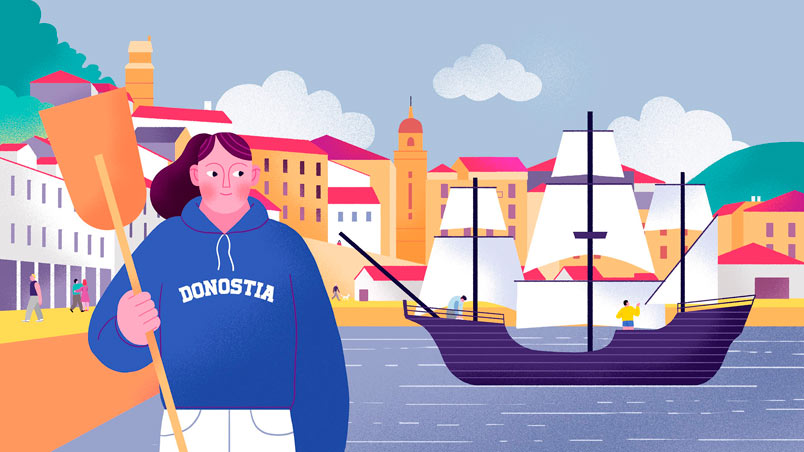Maritime city walking tour

"Hello! I'm Maddi. I'm 19 years old and I'm from the Parte Vieja (Old Town) of San Sebastian. Since I was a child I've had a lot to do with the sea. My family lives in the port and every day I see the sea from my window at home. My memories are closely related to the sea."
The city that came into existence overlooking the sea
My grandmother was a net-maker on the quay; my grandfather was a fisherman; I used to go with my parents to buy fresh fish for their restaurant; and I spent my summers in the port playing with my friends.Besides, being a rower has given me an even better knowledge of the sea.
Throughout the tour I will tell you some maritime stories about San Sebastian. Did you know that San Sebastian was a corsair city? And that there was a time when it was a walled city? We’ll learn about the origin of the most important festivals, the link between sailors and cider, and the rebirth of the city after its destruction in 1813, among other things.
Come with me, we'll embark on this adventure together!
Interactive map of the route
Select the locations
Distance
Stops
Time
1. Plaza de la Constitución
Up until the mid-19th century, the whole city was today's Parte Vieja (Old Town) and the festivities were held in the Plaza de la Constitución. Even today it is still the focal point of the city's most important festival: January 20, the day of San Sebastian. The main events are held here, and during its 24 hours of uninterrupted celebration, the drumbeats that set the rhythm of the festivities never rest. In September we celebrate the Euskal Jaiak (Basque Festivities); on the first Saturday in September we celebrate the Sagardo Eguna (Cider Day), and it is usually a great opportunity to sample the juice of several cider makers. Cider was once a very popular beverage on the Basque maritime expeditions to the distant lands of Newfoundland to catch whales and cod, as its consumption meant that the fishermen did not suffer from scurvy, thanks to the vitamin C contained in the drink. In the 19th century, cider was made in the cellars of the houses in the Parte Vieja (Old Town). These were meeting places which, according to researchers, were the origin of the first gastronomic societies.
On December 21, the day of Santo Tomás (Saint Thomas), the square becomes a large market. There was a time when the baserritarras (peasants) used to bring their best products for sale to the square. They would arrive on foot, with horse-drawn carts and donkeys. When transport improved in the towns of Guipúzcoa, the fair was not so necessary, but the baserritarras (peasants) preserved the tradition of coming to San Sebastian on the day of Santo Tomás. Today it is both a tradition and a festival. It is customary to set up txistorra stalls in the square, and to dress up in the traditional costumes of the baserritarras (peasants).
The square is located in the heart of the Parte Vieja (Old Town), and features three-storey houses with numbered balconies, as for a time it was also used as a bullring. In 1813, the siege of the city destroyed a baroque building in the square and the City Council was built in its place. In 1947 the City Council moved to its current location, the Alderdi Eder building, and the Municipal Library was installed here a few years later. Walking past this building, we emerge onto calle San Jerónimo and continue to the right until we reach calle 31 de Agosto. Turn right on this street and you'll come to the Plaza de Kañoyetan (Canyons Square), where you'll come across the Museum of San Telmo and Santa Corda.

1 Plaza de la Constitución
2. Santa Corda and San Telmo
It is one of the oldest and narrowest streets in the city. On this spot one can imagine what the Parte Vieja (Old Town) was like before its destruction in 1813. It is the only street that remains as an example of the old city. The door of calle Santa Corda was one of the entrances to the convent and it was here that the people of San Sebastian used to enter the church. The Dominican convent, built in the 16th century, is today the San Telmo Museum and the Santa Corda entrance is part of it. Inaugurated in 1902, it is the oldest museum in the Basque Country.
Right next door is my parents' restaurant. From the beginning of the tour, you’ll have already guessed that gastronomy is very important in the city. The pintxos and dishes cooked in the restaurants and bars of the Parte Vieja (Old Town) are famous all over the world. San Sebastian is a paradise for food lovers. The pintxo is the symbol of San Sebastian's gastronomy and the Parte Vieja (Old Town) is the neighbourhood that boasts the most pintxo bars in the city.

2 Santa Corda and San Telmo
3. Santa María Church
Returning to calle 31 de Agosto. Santa María Church is on the right, heading towards the port; San Vicente Church is on the left. These two churches have long been associated with two nicknames in the neighbourhood. Thus, those born or living in the vicinity of San Vicente Church are koxkeros - said to refer to the protruding stones of the church ("koxka" in Basque); and those born or living in the vicinity of Santa María Church are joxemaritarras. That is the nickname referred to in the lyrics of the Marcha de San Sebastián, so if you read "Merluza a la koxkera" on the menus of the city's restaurants... now you know why!
We'll head for the portico of the Basilica of Santa María to find out about the relationship between this temple and the sea. The construction of the church, inaugurated in 1774, was paid for by the Royal Guipuzcoan Company of Caracas, with the profits earned from maritime trade. The company played a major role in the economic development of Guipuzcoa, with special influence on San Sebastian in the 18th century. The most important products arriving from America, apart from tobacco, leather, cotton and coffee, were cocoa and pinol, which served to make chocolate together with sugar. Thus, an important luxury industry was created around chocolate in San Sebastian. We can therefore say that the Church of Santa Maria was built with Venezuelan cocoa. The company brought nails, anchors, weapons and military instruments to America, and brought cocoa back.
If we climb the stairs next to the church we can reach Mount Urgull. There is a marvellous view of the city; in its day it was a strategic place for its defence.
From Santa María we'll head towards the port, and continue walking until we reach the Aquarium.

3 Santa María Church
4. Aquarium
For years, the magnificent whale’s skeleton captured off the Basque coast has been the symbol of the Aquarium. The history of San Sebastian itself cannot be understood without delving into whaling. Whaling brought great wealth to the city and to all of Guipúzcoa: they manufactured whale oil, which was of great importance as it was used as fuel. At that time it was the best fuel, it was very luminous and the cleanest.
The harbour ramp in front of the Aquarium is often the scene for grand celebrations. Trawlers taking part in the most important regatta on the Cantabrian coast are welcomed here. The famous "Bandera de la concha". Every year in September, it attracts thousands of fans and is a great event. Like almost all rural sports, regattas are also based on an ancient craft, in this case, the origin of this sport was fishing.
The ramp also hosts one of the most popular events staged by the "Piratas of San Sebastián" during the Semana Grande: the boarding. They are symbolised by Captain Ezkila (in English, the bell). The name was adopted from a 16th century corsair from San Sebastian: Pedro de Aguirre, aka Campanario. In 2003, they carried out the first boarding with rafts assembled by the participants themselves. Hundreds of young people have joined this underground festival. They set off from the ramp and annually board the bay of La Concha.

4 Aquarium
5. Basque Maritime Museum
This is a landmark museum for getting to know the maritime history of the Basque Country. Inaugurated in 1991, it originated in the building of the Consulate of San Sebastian, built in the mid-18th century in the port. This Tower House was created by the Consulate to control port activity and the provision of various services such as the surveillance of the entrance and departure of ships, maritime aid or the preservation of order and safety on the docks. It played an important role in the development of the Real Compañía Guipuzcoana de Caracas and in promoting the industry created around cod and whales.
We are on the port promenade. At home I have been told that this promenade used to be known as the La Jarana neighbourhood. This area was outside the city walls, and therefore, if the sailors arrived at night, the sea wall gate was closed. That is why they stayed in the bars and inns outside the city walls. A festive atmosphere was common in this part of the town. The port has been a great breeding ground for fishermen, sailors and rowers. The neighbourhood's festivities are held on July 16, coinciding with the Virgen del Carmen, the patron saint of fishermen.
The next three stops on the tour will take us far from the Parte Vieja (Old Town). Even so, you'll see that they are also closely linked to the sea and the Parte Vieja (Old Town).

5 Basque Maritime Museum
6. Provincial Council of Guipúzcoa
We are in the Plaza de Guipúzcoa, we stand in front of the façade of the headquarters of the Provincial Council of Guipúzcoa and we'll look towards the top. We'll reach five white busts. Who are they?
Five sailors and explorers from Guipuzcoa: Andrés de Urdaneta -who discovered and documented the return voyage from the Philippines to Mexico-, Juan Sebastián Elcano -who sailed around the world-, Blas de Lezo -head of the Spanish Navy-, Antonio de Oquendo y Zandategui -son of Admiral Miguel de Oquendo- and Miguel López Legazpi -founder of the Philippine city of Manila-.
The coat of arms of Gipuzkoa can be seen above them. The five sailors from Gipuzkoa worked serving the Spanish crown as soldiers, sailors, secretaries or scribes.

6 Provincial Council of Guipúzcoa
7. Oquendo House
We are heading towards the Gros neighbourhood. Specifically, to the slopes of Mount Ulía. In what is now the Sagues area, in calle Zemoria, we come across a 16th century palace: the house of the Oquendo family. Today, this historic building is part of the Okendo cultural centre, the municipal cultural centre of the Gros neighbourhood.
The Oquendo family was one of the most important families in the history of San Sebastian in the 16th and 17th centuries. Miguel de Oquendo was one of the generals who led the Armada Invincible in 1588. The intention was to attack England, but that expedition was a failure and many sailors from San Sebastian died.
If we continue up calle Zemoria, we can climb up through the Ulía forest, and at this point we'll come across the Whaler's watchtower. In the Middle Ages, the fishermen of San Sebastian fished for whales and cod, exploiting the blubber and the baleen of the cetaceans to make a whole range of utensils.
We'll find countless trails to wander along the slopes of Ulía and we can even reach the cliffs to enjoy the coastline and admire this spectacular natural area. We are about to finish the tour; the last stop will be at the Paseo de La Concha, on the Bicentenario Balcony.

7 Oquendo House
8. Bicentenario Balcony
One of the most tragic events in the history of San Sebastian is recalled here. A beautiful view of La Concha Bay and the Parte Vieja (Old Town) lies before us, but if we were to go back to August 31, 1813, we would see nothing but fire, cannon fire and smoke. The city was occupied by Napoleon's French troops. After two months of siege, British and Portuguese soldiers managed to enter the walled city. They drove the French out, but sacked the city and destroyed it. The city we know today is built on the ashes of that San Sebastian.
It was a tremendous massacre and destruction. The soldiers forced their way into the people's homes, burned houses, committed robberies, raped women and killed about a thousand citizens... and those who managed to survive struggled to get by. Eventually they made it. In fact, there is a sculpture in Plaza de Kañoyetan in the Parte Vieja (Old Town) that is a tribute to all those people who rebuilt the city. It has become a symbol of the courage displayed by the people of San Sebastian; the sculpture of a woman ready to rebuild the city brick by brick is a reminder of that tragedy.

8 Bicentenario Balcony
Green Routes accessibles and interactives





















![Basílica de Santa María del Coro (portada principal). Alfred Hitchcock (director y productor de Vertigo / De entre los muertos [Sección Oficial])](/images/mapa-ciudad-maritima/iglesia-santa-maria-hitchcock.jpg)































